CATIA V5自学教程1
CATIA基础教程1(基本操作)

基本操作技巧— 二、基本操作技巧 鼠标操作
I.
选择 利用鼠标左键单击模型或树形图对整个模型或模型的局部 进行选择,所选择的部分就会高亮显示出来。 进行选择,所选择的部分就会高亮显示出来。
左键: 左键: 确定位置、选取图像对象、 确定位置、选取图像对象、菜单 或图标 右键: 右键: 单击右键, 单击右键,弹出上下文相关菜单
CATIA基础教程 CATIA基础教程
——基本操作 ——基本操作
主要内容
1 2 3 4 5
CATIA V5的工作界面介绍 的工作界面介绍 基本操作技巧 工作环境设置 用户工作界面定制
一、CATIA V5的工作界面介绍 的工作界面介绍
1. CATIA V5 的用户界面主要由菜单栏、工具栏、命令行和工作 的用户界面主要由菜单栏、工具栏、 等组成,如下图所示。 窗口等组成,如下图所示。
基本操作技巧— 二、基本操作技巧 指南针操作
2.
指南针 指南针代表着模型的三维空间坐标系。 指南针代表着模型的三维空间坐标系。它是由与坐标轴平行 的执行和三个圆弧组成的,其中 和 轴方向各有两条直线 轴方向各有两条直线, 轴 的执行和三个圆弧组成的,其中X和Y轴方向各有两条直线,Z轴 方向只有一条直线。这些直线与圆弧组成平面,分别于相应的坐 方向只有一条直线。这些直线与圆弧组成平面, 标平面平行。 标平面平行。 指南针主要的两项功能是: 指南针主要的两项功能是: 改变模型的显示位置——视点操作 视点操作 改变模型的显示位置 改变模型的实际位置——模型操作 模型操作 改变模型的实际位置
三、工作环境设置
设置CATIA的工作环境是用户学习和使用 的工作环境是用户学习和使用CATIA应该掌握 设置 的工作环境是用户学习和使用 应该掌握 的基本技能,合理设置CATIA的工作环境,对于提高工作效率 的基本技能,合理设置 的工作环境, 的工作环境 使用个性化环境具有极其重要的意义。 、使用个性化环境具有极其重要的意义。 环境设置主要包括“选项”设置和“标准”设置。 环境设置主要包括“选项”设置和“标准”设置。 1. 选项设置 选择工具-【选项】命令,系统弹出“选项”对话框,利 选择工具 【选项】命令,系统弹出“选项”对话框, 用该对话框可以设置草图绘制器、显示、工程制图参数。 用该对话框可以设置草图绘制器、显示、工程制图参数。“ 选项”对话框如下图所示。 选项”对话框如下图所示。
CATIA教程基础操作

第一章 CATIA V5的三维世界
4. 缩放
在工作空间任何位置,按下鼠标中键不放,再单击鼠标左键或右键,上下拖 动鼠标可对工作空间中的设计元素进行缩放。
第一章 CATIA V5的三维世界
二、罗盘操作
在CATIA V5工作空间右上角有一个罗盘,代表元素的三维坐标系。利用罗 盘可对元素进行各种移动与旋转操作。
第一章 CATIA V5的三维世界
一、基础结构模组
基础结构模组(Infrastructure) 功能,为高效设计提供了可能。
包括了各种基础图素,如标准件的设计
基础结构模组 Infrastructure
产品结构 Product Structure
虚拟环境配置助手 Immersive System Assistant
菜单 工具栏 对话框 设计树 罗盘 设计空间 其它
菜单项包含了所有的操作命令。 利用工具按钮可完成大部分操作命令的快速启动。 利用对话框可进行某些设计参数的选择和定义。 设计树利用树状结构记录了设计历程。 罗盘是一个十分便利的设计工具,具有很多功能。 窗体内用于设计的工作空间。 包括坐标系、参考平面及命令栏等。
2. 面平移
选择罗盘上的任意平面,按下鼠标左键拖动鼠标,则工作空间中的元素沿该 平面移动。
第一章 CATIA V5的三维世界
3. 绕坐标轴转动
选择罗盘上绕轴旋转线(各平面上的弧线),按下鼠标左键拖动鼠标,则工 作空间中的元素绕与该平面垂直的坐标轴转动。
第一章 CATIA V5的三维世界
4. 自由转动
CATIA教程
CATIA培训
第一章 CATIA V5的三维世界
第一章 目录
★第一节 基本介绍 ★第二节 CATIA V5 体系结构 ★第三节 CATIA V5 通用操作 ★第四节 CATIA V5的环境设置
2024版CATIAV5从入门到精通(第二版)[1]
![2024版CATIAV5从入门到精通(第二版)[1]](https://img.taocdn.com/s3/m/a9cd476dcdbff121dd36a32d7375a417866fc1e4.png)
图纸打印与输出
设置打印参数,输出纸质或电子版图纸。
2024/1/29
31
案例四:综合应用实战演练
01
项目需求分析与规划
分析实际项目需求,制定实施计划。
03
装配体设计与仿真
完成装配体设计,进行运动仿真及 性能分析。
2024/1/29
02
零件设计与建模
运用CATIA V5进行零件设计、建模 及优化。
安装CATIAV5的硬件和软件 要求
01
运行安装向导,选择安装类
型
02
03
设置软件安装路径和相关选 项
04
2024/1/29
05
完成安装并启动CATIAV5
4
界面介绍与基本操作
了解CATIAV5的用户界面
2024/1/29
学习如何创建、打开和保 存文档
掌握基本鼠标操作和键盘 快捷键
熟悉常用工具栏和命令菜 单
04
工程图设计与输出
根据项目要求,设计并输出工程图 纸。
32
THANKS
感谢观看
2024/1/29
33
5
基本图形绘制与编辑
2024/1/29
学习绘制直线、圆、圆弧、 矩形和多边形等基本图形
Байду номын сангаас04
熟悉尺寸标注和文本注释的 方法
01 03
掌握图形的修剪、延伸、倒 角和圆角等编辑操作
02
学习使用图层、颜色和线型 等属性设置图形
6
视图操作与显示控制
学习使用视图管理 器管理多个视图
了解剖视图和局部 视图等高级视图功 能
2024/1/29
CATIA_V5教程-第1章__Catia_V5_R18使用概述

1-2
1.2 Catia V5 R18基本功能
Catia具有所有CAD/CAM软件的基本功能,如绘制二维、三 维图形及工程图。作为新一代的CAD/CAM/CAE软件, 已被广泛应用于航空航天、机械、建筑等领域。随着经 济的发展,被越来越多的用户所接受。下面简要介绍 Catia的基本功能。
1-3
1.2.1 绘制二维图形
第1章 Catia V5 R18使用概述
本章主要介绍Catia主要特点、基本功能、操作界面等基础 信息。让读者掌握标题栏、菜单栏、工具栏、结构树、 各设计模块在软件中的位置和作用,有利于后续课程的 学习。
1-1
1.1 Catia V5 R18概述
Catia是英文Computer Aided Tri-Dimensional Interface Application的缩写,是法国Dassault公司于1975 年起开始 发展的一套完整的3D CAD/CAM/CAE一体化软件。它的 内容涵盖了产品从概念设计、工业设计、三维建模、分 析计算、动态模拟与仿真、工程图的生成到生产加工成 产品的全过程,其中还包括了大量的电缆和管道布线、 各种模具设计与分析、人机交换等实用模块。Catia不但 能够保证企业内部设计部门之间的协同设计功能,而且 还可以提供企业整个集成的设计流程和端对端的解决方 案。Catia大量用于航空航天、汽车及摩托车行业、机械 、电子、家电与3C产业、NC加工等各方面。
1-4
1.2.2 绘制三维图形
Catia具有强大的三维实体建模功能,用来轻松创建各种复 杂的三维实体模型。可以采用拉伸、旋转、混合、扫描 等三维建模工具,也可以创建各种边界曲线,然后通过 曲线生成各种曲面,最后由曲面生成三维实体。通过这 些方法,可以满足三维设计的要求,如图所示为创建的 三维实体模型。
CATIA_V5自学教程1

CATIA V5培训教程1以CATIA V5.11为例,它提供以下几种模块,每种模块中又有数个子单元。
(1)基础构架Infrastructure提供管理整个CATIA 构架的功能,包括Product Structure、Material Library、Catalog Editor、Rendering等:(2)机械设计Mechanical Design包含机械设计的相关单元,主要有以下几部分组成:(3)造型Shape提供曲面与逆向工程设计单元,可以自由塑造不规则曲面,利用手绘草图来构件曲面。
(4)分析与仿真Analysis & Simulation提供实体的网格划分(mesh)与静力、共振等有限元分析功能,并可输出网格分割数据共其它分析软件使用。
(5)APC 工厂布局提供工厂的规划建制功能。
(6)数控加工NC Manufacturing包含两轴到五轴加工的编程能力,并支持快速原型功能(STL Rapid Prototyping)。
(7)数字化仿真Digital Mockup包含动态机构仿真、装配配合空间分析、产品功能分析与功能优化等。
(8)设备与系统Equipment and Systems提供各种系统设备的建置,管路和电线的配置以及电子零件配置等功能。
(9)制造的数字化过程Digital Process for Manufacturing 提供在三维空间中进行产品的特征、公差与配合标注等功能。
(10)人体工学设计与分析Ergonomics Design&Anaysis提供人体模型,并可对产品进行人体空间分析。
(11)智能软件Knowledgeware一. 基本使用环境本章主要介绍CA TIA用户的基本操作界面、使用技巧、树结构(Tree)以及文件File、编辑Edit和视图View等菜单的操作等。
2.1 CATIA 的用户界面CATIA User Interface操作窗口菜单及工具条CA TIA对话框的组成2.2 操作技巧1. 鼠标的使用(1)使用三键鼠标,利用鼠标可以完成数种功能,包括选择和编辑对象、移动视角、右击打开弹出式菜单、旋转视角、物体的缩放等,具体使用如下:(2)选择和编辑对象:点击MB1(3)移动物体Translate:用MB2,按住中间不放,则物体随鼠标的移动而移动。
CATIA V5 机械设计案例教程 第1章 CATIA V5概述
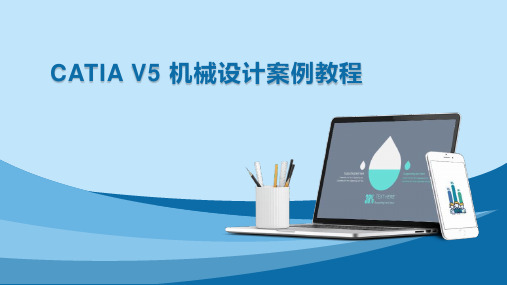
CATIA V5是在Windows NT平台和UNIX平台上开发完成。在 Windows平台的应用可以使设计师更加简便地同办公应用系统共 享数据;而UNIX平台上的NT风格的用户界面,可使用户在UNIX平 台上高效地处理复杂的工作。CATIA V5版本包括概念布局设计、 工业设计、机械设计、模塑产品设计、钣金设计、线束布局设计、 管路设计、逆向工程、有限元及结构分析、人机工程、电子样机 工程、三轴加工设计等多个模块。
表1-1 各种按键的使用方法
按键
单击左键
双击左键
按下左键并拖动鼠标 单击鼠标右键 单击滚轮 按下击鼠标右键 并前后移动鼠标
功能 可选择命令、选择对象,在CATIA V5工作界面中选中的对象以橘黄色显示。按下Ctrl键时单击 左键,可进行连续选择。选择对象时,在几何图形区与在设计特征树上选择是相同的,并且是 关联的 双击命令图标,可连续执行同一命令;在其他对象上双击左键可弹出相应对话框或其他有关信 息 可框选对象、移动对象,如移动草图中的未约束图形元素 在要选择的对象上单击鼠标右键,弹出可供多项选择的快捷菜单 在物体上单击滚轮,可将选中的点移到作图区中心 可移动草图或物体
启动CATIA软件后,只显示如图1-7所示的3排工具栏,其他 工具栏都隐藏在界面右下角的位置。当鼠标左键按住如图1-10所 示箭头所指位置的灰色双箭头或灰杠时,就会拖出若干工具栏。 当此处没有灰色双箭头或灰杠时,表示工具栏全部拖出。不需要 的工具栏单击其上的关闭按钮 即可,需要的工具栏用左键按住 灰杠拖至合适位置。要调出关闭的工具栏,可在任一工具栏上单 击鼠标右键,在弹出如图1-11所示的快捷菜单上选择需要的工具 栏。
CATIA V5 机械设计案例教程
CATIA软件的全称是Computer Aided Tri-Dimensional Interface Application(计算机辅助三维交互应用),它是由 法国著名飞机设计师和航空工业企业家达索(原名马塞尔·布洛 赫)为首创建的世界著名的航空航天企业—法国达索飞机制造公 司旗下的达索系统公司开发的CAD/CAE/CAM/PLM于一体的工程设 计软件。CATIA诞生于20世纪70年代,最早用于幻影系列和阵风 战斗机的设计制造中。
catia v5 实用教程 第1章
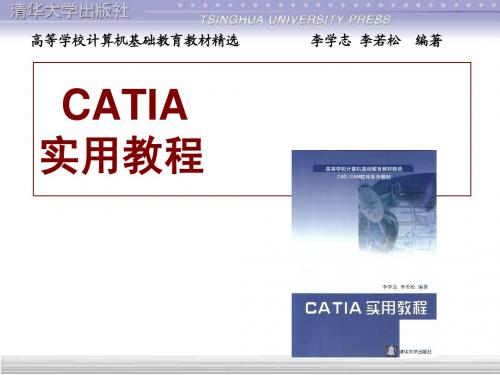
5. 创成式零件结构分析GPS模块 可以带给用户对设计进行有限元分析预校验的能 力。通过专为设计人员提供的简单易学的界面,设 计者可以容易的理解分析计算结果,进行初级的机 械及振动行为分析。借助颜色编码的图形功能,可 以直观地显示变形,位移和应力。该产品还可以根 据实际零件的状况对分析零件添加约束条件。 6. 实时渲染RT1模块 可以让设计师对其设计应用色彩渲染效果和材料 规格进行说明。用户可以通过手工绘制,直接修改 已输入的数字化图像或系统提供的库中选择进行纹 理生成。可以管理材料库和零件应用之间的关联。
1. 软件环境 Microsoft公司的Windows 2000/XP或NT,IBM公 司的AIX,HP公司的HP-UX,SGI公司的IRIX等操作 系统。
1.3 CATIA的主要功能模块 1. 创成式工程绘图GDR模块 利用3D模型生成相关联的工程图。图纸生成辅助器可大大 简化绘制多视图的工作,并且可以自动生成尺寸标注。可以 建立与零件材料规格说明相关联的剖面线,可以进行基于标 准的附加信息和注释等后处理。图纸与3D主模型的几何关联 性可使用户并行地进行设计和工程绘图工作。同时还可输出 DXF格式的数据文件。 2. 交互式工程绘图ID1模块 高效,直观的交互式绘图,进行产品的2D设计。可以在一 个以CATIA为主干系统的扩展型企业中,供所有2D CAD 用户 使用。ID1产品集成化的2D交互功能和高效的辅助作图和注 释从两方面进一步丰富了CATIA创成式工程绘图功能,它为 用户提供了更加容易和流畅的从2D设计过度到3D设计方式的 转变过程。
7. 运动机构模拟KIN模块 通过系统提供的关节联结方式或自动转换装配约束条件而 产生关节连接,可以对任何规模的电子样机进行机构定义。 通过鼠标操作,能够模拟机械运动以校验机构性能。通过干 涉检验和分析最小间隙来进行机构的运动分析。可以生成运 动零件的轨迹或扫掠体以指导未来设计。还可以通过与其他 DMU产品的集成做更多组合的仿真分析。能够满足从机械设 计到功能评估的各类工程人员的需要。 8. 空间分析SPA模块 可以进行电子样机的干涉检查,断面分析和3D几何尺寸比 较等验证。可以进行碰撞,间隙及接触等计算,并得到更为 复杂和详尽的分析结果。剖面观察器可以帮助用户对曲线进 行分析和标注。还能够比较3D几何体,并将结果进行可视化 显示。通过与CATIA目标管理器COM的集成,能够进行质量和 惯性测量和计算。
CATIA_V5线束设计入门简易教程
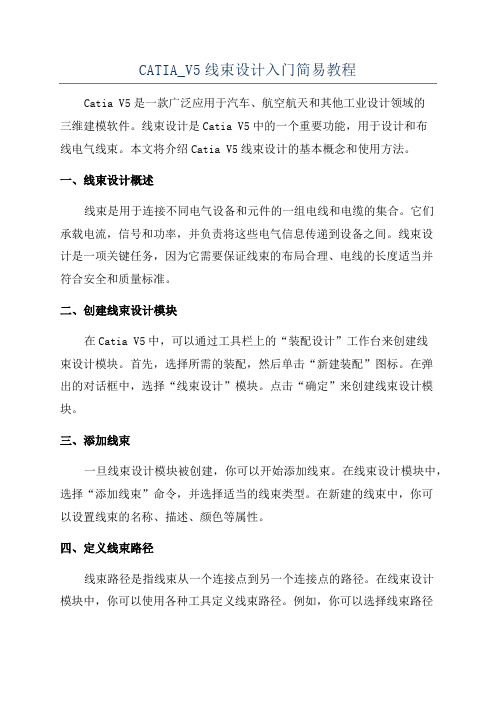
CATIA_V5线束设计入门简易教程Catia V5是一款广泛应用于汽车、航空航天和其他工业设计领域的三维建模软件。
线束设计是Catia V5中的一个重要功能,用于设计和布线电气线束。
本文将介绍Catia V5线束设计的基本概念和使用方法。
一、线束设计概述线束是用于连接不同电气设备和元件的一组电线和电缆的集合。
它们承载电流,信号和功率,并负责将这些电气信息传递到设备之间。
线束设计是一项关键任务,因为它需要保证线束的布局合理、电线的长度适当并符合安全和质量标准。
二、创建线束设计模块在Catia V5中,可以通过工具栏上的“装配设计”工作台来创建线束设计模块。
首先,选择所需的装配,然后单击“新建装配”图标。
在弹出的对话框中,选择“线束设计”模块。
点击“确定”来创建线束设计模块。
三、添加线束一旦线束设计模块被创建,你可以开始添加线束。
在线束设计模块中,选择“添加线束”命令,并选择适当的线束类型。
在新建的线束中,你可以设置线束的名称、描述、颜色等属性。
四、定义线束路径线束路径是指线束从一个连接点到另一个连接点的路径。
在线束设计模块中,你可以使用各种工具定义线束路径。
例如,你可以选择线束路径终点并指定它的位置、方向和角度。
你还可以使用“路线优化”工具自动优化线束路径。
五、添加电线在线束设计模块中,你可以为线束添加电线。
选择“添加电线”命令,并选择适当的电线类型。
然后,你可以指定电线的节点、方向、长度和其他属性。
你还可以使用连接器定义电线的连接点和插头。
六、检查线束设计完成线束设计后,你可以使用各种工具检查线束的合理性和质量。
例如,你可以使用“线束可视化”工具查看线束的路径和布局。
你还可以使用“线束树形图”工具查看线束的层次结构和组件信息。
七、导出线束设计一旦线束设计完成,你可以将其导出为其他格式,以便与其他软件进行兼容。
在Catia V5中,你可以选择“导出为”命令,并选择所需的文件格式。
然后,你可以选择保存位置和文件名,并点击“保存”按钮。
CATIA V5从入门到精通[共11页]
![CATIA V5从入门到精通[共11页]](https://img.taocdn.com/s3/m/00c6f2b148d7c1c709a1457c.png)
CATIA V5从入门到精通李成编著人民邮电出版社北京内 容 提 要本书是一本系统全面详解CATIA功能知识点与深入剖析工程应用的指导性教材。
读者通过本书能够快速、深入地学习知识点内容,掌握该软件的工程应用方法,并积累一定的工程实践经验。
本书分7篇共24章。
第1篇CATIA V5基础与入门操作,包含第1~2章,分别介绍软件各模块菜单、草绘元素的绘制等内容。
第2篇实体建模与钣金设计,包含第3~6章,主要介绍实体零件的建模,模块实体修饰命令,及各类参考元素的建立等内容和实例。
并重点介绍钣金模块的各项功能,钣金综合实例。
第3篇曲面设计,包含第7~10章,主要介绍常规曲面GSD模块的各类功能,常规曲面的各类编辑命令,自由曲面模块的各类命令,自由曲面的分析等内容。
第4篇装配设计与工程图,包含第11~12章,主要介绍装配模块各类命令的使用方法及装配实例,介绍工程图模块的各类命令和工程图综合实例。
第5篇逆向工程,包含第13~14章,介绍数字曲面模块DSE,数字曲面实例,以及曲面的快速重建模块QSR等内容。
第6篇CATIA V5综合实例,包括第15~17章,以汽车转向机总成模型为例,系统地介绍轴类、盘类、箱体类、叉架类零件的实体建模过程、装配过程、出工程图过程。
系统地介绍种子部件的应用、曲面质量分析、关联性设计等内容,实体、曲面组合型实例,并以拖拉机模型为例,综合运用实体、曲面自上而下和自下而上的设计过程,有关联性设计,也有独立性设计。
第7篇常见疑难问题解答,包括第18~24章,分别介绍草图、实体设计、曲面设计、钣金设计、装配设计、工程图、逆向工程等7个模块使用过程中的一些经验和实战技巧。
本书适合CATIA初、中级用户,相关领域的工程技术人员,院校相关专业师生,行业软件培训班学员,想快速掌握CATIA软件并应用于实际工程的读者阅读。
CATIA V5从入门到精通♦编著李 成责任编辑张涛♦人民邮电出版社出版发行北京市崇文区夕照寺街14号邮编 100061 电子函件 315@网址 北京铭成印刷有限公司印刷♦开本:787⨯1092 1/16印张:33.75字数:891千字2010年7月第1版印数:1 – 3 000册2010年7月北京第1次印刷ISBN 978-7-115-23042-3定价:69.00元(附光盘)读者服务热线:(010)67132692 印装质量热线:(010)67129223反盗版热线:(010)67171154。
CATIA V5基础教程 教学课件 ppt 作者 刘娜 第1章

1.4 CATIA V5 工作界面
1.4.2 工作界面简介
CATIA工作界面
1.4 CATIA V5 工作界面
1.4.3 鼠标操作 1. 选择
用鼠标左键单击模型或单击树形图零件的部 分,则选中部分会以高亮显示,接下来用户 便可对其进行下一步操作,如 2. 移动 按住鼠标中键在窗口区域拖动,此时鼠标会 变成十字符号,零件便会随着鼠标的移动而 移动,而零件在空间的相对坐标不变。
1.1 入门引例——创建平键
1.2 CATIA V5软件的特点
CATIA是法国达索公司〔Dassault Systems〕推出的 一款CAD/CAE/CAM软件,它能在Windows98/ME、 Windows2000/XP以及UNIX等平台上运行,是目前国 际上应用范围最广、影响最大的CAD软件。
旋转分为模型绕一点旋转和模型绕一轴旋转。 选择指南针z轴上的圆头,按住鼠标左键并移动 鼠标,则指南针以红色方块为顶点自由旋转,工 作窗口中的模型也会随着指南针一同旋转。选择 xy平面上的弧线按住鼠标左键并移动鼠标,则指 南针会绕z轴旋转,另外两个平面也适用。
1.4 CATIA V5 工作界面
1.4.5 定制工作界面
1.2 CATIA V5软件的特点
CATIA主要用于自动化和航空工业的汽车和飞机等产 品的开发。CATIA同时也可以用于其他的许多工业领 域,包括航空器械、建筑自动化、生活消费品、电 子医药、家具、机械模具以及造船等领域。
1.2 CATIA V5软件的特点
CATIA提供方便的解决方案,迎合了所有大、中、小型企 业的需要,几乎涵盖所有的制造产品。CATIA凭借其强大 的设计模拟制造一体化功能,目前在全球拥有24 000多个 客户,日常生产中使用的超过180 000套。CATIA的著名用 户包括波音、宝马、奔驰、沃尔沃等一大批国际知名企 业,在国内上海大众、一汽大众、北京吉普、华晨宝马、 哈飞汽车等也采用了CATIA设计技术,可以说其用户群体 在世界制造业中据有举足轻重的地位。而波音飞机公司 使用CATIA完成了整个波音777的电子装配,创造了业界 的一个奇迹,从而也确定了CATIA 在CAD/CAE/CAM 行业 内的领先地位。
CATIA V5R20中文版完全自学一本通

7.4.1动手操练——创建曲面印记 7.4.2动手操练——创建凸起特征 7.4.3动手操练——创建曲线印记 7.4.4动手操练——创建轮缘切除 7.4.5动手操练——创建气栅 7.4.6动手操练——创建桥接 7.4.7动手操练——创建轮缘孔 7.4.8动手操练——创建圆形印记 7.4.9动手操练——创建加强肋
03
9.3生成装 饰特征
04
9.4打印工 程图
06
9.6练习题
05
9.5本章小 结
9.1.1动手操练——基本设置 9.1.2动手操练——创建投影视图 9.1.3动手操练——创建截面视图 9.1.4动手操练——创建局部放大视图 9.1.5动手操练——创建局部视图 9.1.6动手操练——创建断开视图 9.1.7动手操练——创建模板视图 9.1.8综合演练——齿轮工程视图
7.2.1动手操练——创建等半径折弯圆角 7.2.2动手操练——创建变半径折弯圆角 7.2.3动手操练——创建折弯 7.2.4动手操练——创建展开 7.2.5动手操练——创建收合 7.2.6动手操练——创建映射
7.3.1动手操练——创建凹槽 7.3.2动手操练——创建止裂槽 7.3.3动手操练——创建圆弧切割
10.3.1动手操练——创建拉伸曲面 10.3.2动手操练——创建偏移曲面 10.3.3动手操练——创建扫掠曲面 10.3.4动手操练——创建填充曲面 10.3.5动手操练——创建多截面曲面 10.3.6动手操练——创建桥接曲面 10.3.7动手操练——创建高级曲面
10.4.1动手操练——创建曲面接合和修复 10.4.2动手操练——曲面的分割与修剪 10.4.3动手操练——提取曲面/曲线 10.4.4动手操练——创建曲面圆角 10.4.5动手操练——创建曲面转换 10.4.6动手操练——创建延伸
CATIA基础操作(初学者)
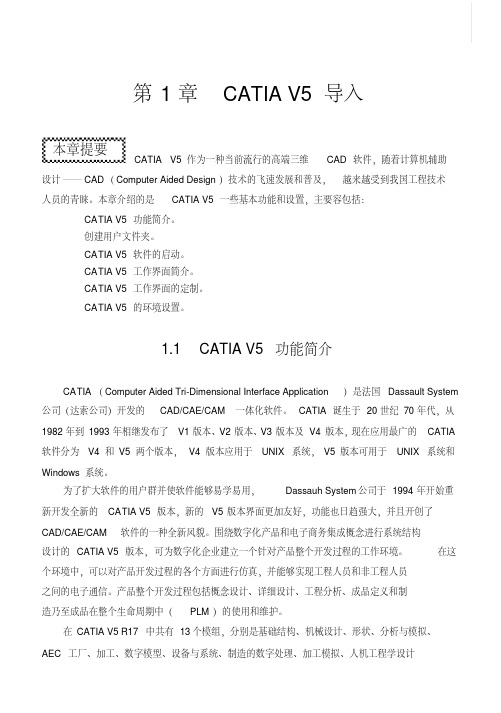
本章提要第1章CATIA V5导入CATIA V5作为一种当前流行的高端三维CAD软件,随着计算机辅助设计──CAD(Computer Aided Design)技术的飞速发展和普及,越来越受到我国工程技术人员的青睐。
本章介绍的是CATIA V5一些基本功能和设置,主要容包括:CATIA V5功能简介。
创建用户文件夹。
CATIA V5软件的启动。
CATIA V5工作界面简介。
CATIA V5工作界面的定制。
CATIA V5的环境设置。
1.1 CATIA V5功能简介CATIA(Computer Aided Tri-Dimensional Interface Application)是法国Dassault System 公司(达索公司)开发的CAD/CAE/CAM一体化软件。
CATIA诞生于20世纪70年代,从1982年到1993年相继发布了V1版本、V2版本、V3版本及V4版本,现在应用最广的CATIA 软件分为V4和V5两个版本,V4版本应用于UNIX系统,V5版本可用于UNIX系统和Windows系统。
为了扩大软件的用户群并使软件能够易学易用,Dassauh System公司于1994年开始重新开发全新的CATIA V5版本,新的V5版本界面更加友好,功能也日趋强大,并且开创了CAD/CAE/CAM软件的一种全新风貌。
围绕数字化产品和电子商务集成概念进行系统结构设计的CATIA V5版本,可为数字化企业建立一个针对产品整个开发过程的工作环境。
在这个环境中,可以对产品开发过程的各个方面进行仿真,并能够实现工程人员和非工程人员之间的电子通信。
产品整个开发过程包括概念设计、详细设计、工程分析、成品定义和制造乃至成品在整个生命周期中(PLM)的使用和维护。
在CATIA V5 R17中共有13个模组,分别是基础结构、机械设计、形状、分析与模拟、AEC工厂、加工、数字模型、设备与系统、制造的数字处理、加工模拟、人机工程学设计与分析、智件和ENOVIA V5 VPM (如图 1.1.1所示),各个模组里又有一个到几十个不同的工作台。
CATIA V5详细教程--零件设计(1)
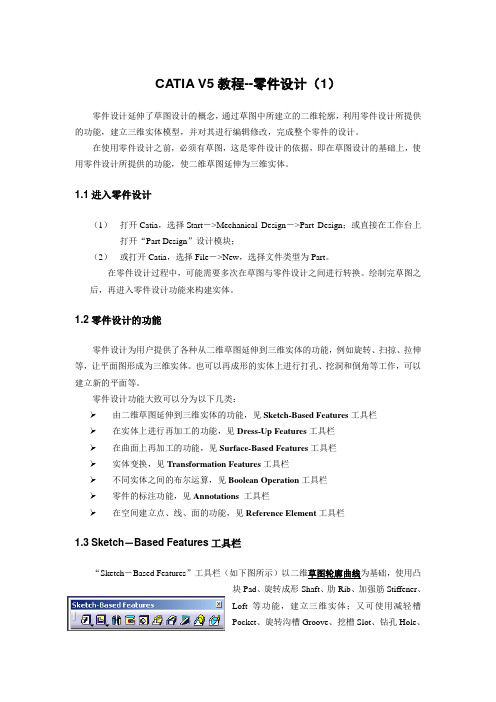
CATIA V5教程--零件设计(1)零件设计延伸了草图设计的概念,通过草图中所建立的二维轮廓,利用零件设计所提供的功能,建立三维实体模型,并对其进行编辑修改,完成整个零件的设计。
在使用零件设计之前,必须有草图,这是零件设计的依据,即在草图设计的基础上,使用零件设计所提供的功能,使二维草图延伸为三维实体。
1.1进入零件设计(1)打开Catia,选择Start->Mechanical Design->Part Design;或直接在工作台上打开“Part Design”设计模块;(2)或打开Catia,选择File->New,选择文件类型为Part。
在零件设计过程中,可能需要多次在草图与零件设计之间进行转换。
绘制完草图之后,再进入零件设计功能来构建实体。
1.2零件设计的功能零件设计为用户提供了各种从二维草图延伸到三维实体的功能,例如旋转、扫掠、拉伸等,让平面图形成为三维实体。
也可以再成形的实体上进行打孔、挖洞和倒角等工作,可以建立新的平面等。
零件设计功能大致可以分为以下几类:➢由二维草图延伸到三维实体的功能,见Sketch-Based Features工具栏➢在实体上进行再加工的功能,见Dress-Up Features工具栏➢在曲面上再加工的功能,见Surface-Based Features工具栏➢实体变换,见Transformation Features工具栏➢不同实体之间的布尔运算,见Boolean Operation工具栏➢零件的标注功能,见Annotations工具栏➢在空间建立点、线、面的功能,见Reference Element工具栏1.3Sketch-Based Features工具栏“Sketch-Based Features”工具栏(如下图所示)以二维草图轮廓曲线为基础,使用凸块Pad、旋转成形Shaft、肋Rib、加强筋Stiffener、Loft等功能,建立三维实体;又可使用减轻槽Pocket、旋转沟槽Groove、挖槽Slot、钻孔Hole、移除Loft曲面等功能,修改三维实体。
CATIA V5_快速入门教程 第01章 CATIA V5功能概述
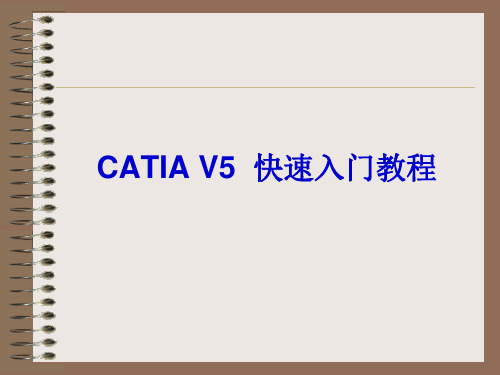
第1章 CATIA V5简介
本章内容主要包括: 用CAD工具进行产品设计的一般过程。 CATIA V5主要功能模块简介。 CATIA V5软件的特点。
1.1 CAD产品设计的一般过程
应力分析
可选过程
结构强度分析 疲劳分析
塑料流动
概念设计
工业造型
NC仿真及优化
1.3 CATIA V5 软件的特点
CATIA V5作为一个大型CAD/CAM应用软件,具有如下 特点: 基于Windows平台开发的系统,易于使用。 知识驱动的CAD/CAM系统。 先进的电子样机技术。 先进的混合建模技术。 支持并行工程。 实现资源共享,构造数码企业。 易于发展电子商务。 优良的可扩展性,保护用户投资。
可选过程
动态仿真
图1.1.1 CAD产品设计一般流程
1.2 CATIA V5功能模块简介
1.“基础结构”模组 2.“机械设计”模组 3.“形状”模组 4.“分析与模拟”模组 5.“AEC工厂”模组 6.“加工”模组 7.“数字模拟”模组 8.“设备与系统”模组 9.“人机工程学设计与分析”模组 10.“智件”模组
11cad产品设计的一般过程概念设计零部件三维建模二维工程图工业造型应力分析结构强度分析疲劳分析塑料流动可选过程公差分析与优化nc仿真及优化动态仿真热分析可选过程图111cad产品设计一般流程12catiav5功能模块简介1
CATIA V5 快速入门教程
目录
第01章 CATIA V5功能概述 第02章 CATIA V5软件的安装 第03章 软件的工作界面与基本设置 第04章 二维草图的设计 第05章 零件设计 第06章 装配设计 第07章 曲面设计 第08章 模型测量与分析 第09章 工程图设计
第1章 CATIA V5基础知识
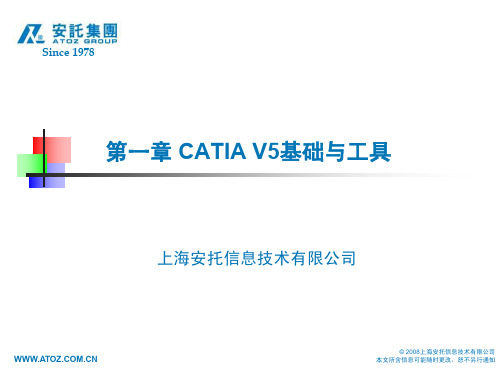
3、界面组成
文件名
Since 1978
菜单 罗盘 工具栏 零件特征树
图形工作区
Sketcher 入口...
Since 1978
选择:把鼠标移动到要选择的选项上,点 左键
移动:按住中键,拖动鼠标
放大缩小:按住中键,再按一下右键,中键 不放,拖动鼠标即可 旋转:按住中键及右键拖动鼠标即可
多次选择:某些操作要多次选择时,双击 左键即可
右键弹出对话框:选择窗口中的某物件, 电击右键即可
,打开、关闭文件 ②
最近打开的文件
续。。。。。。(文件管理)
Since 1978
④ 保存文件,从File菜单中选择
,命令。或者按下快捷键Ctrl+S,或者按工具栏中的“保存”按钮。
同时可以进行另存
,全部保存
,保存管理
等保存方式。
5、三键鼠标的使用
6、特征树的操作
Since 1978
树的显示,隐藏:按F3键
移动,放大,缩小:点击右下脚的坐标或者树 干,使屏幕变暗,其它操作参照前面鼠标操 作
集的操作:插入,移动
树的展开及收拢:
查找父代、子代及快速查找功能
7、属性修改
Since 1978
我们可以修改特征或者零部件的名称、颜色、线性等属性
The End
Since 1978
2024年CATIAv5入门培训教程
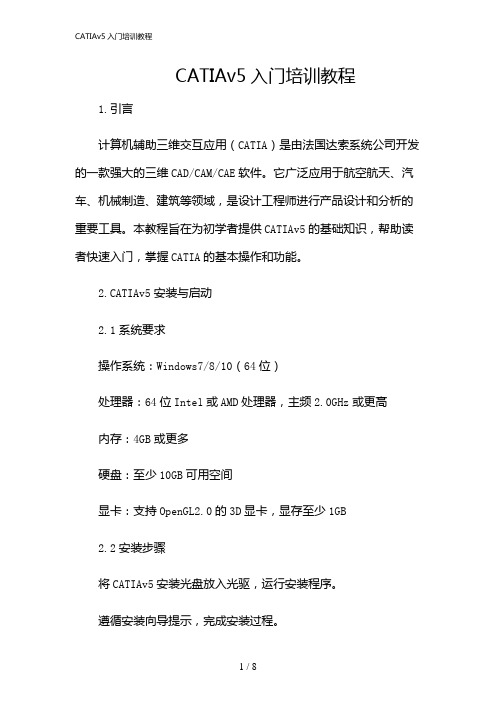
CATIAv5入门培训教程1.引言计算机辅助三维交互应用(CATIA)是由法国达索系统公司开发的一款强大的三维CAD/CAM/CAE软件。
它广泛应用于航空航天、汽车、机械制造、建筑等领域,是设计工程师进行产品设计和分析的重要工具。
本教程旨在为初学者提供CATIAv5的基础知识,帮助读者快速入门,掌握CATIA的基本操作和功能。
2.CATIAv5安装与启动2.1系统要求操作系统:Windows7/8/10(64位)处理器:64位Intel或AMD处理器,主频2.0GHz或更高内存:4GB或更多硬盘:至少10GB可用空间显卡:支持OpenGL2.0的3D显卡,显存至少1GB2.2安装步骤将CATIAv5安装光盘放入光驱,运行安装程序。
遵循安装向导提示,完成安装过程。
2.3启动与关闭安装完成后,在桌面或开始菜单中找到CATIAv5的快捷方式,启动。
使用完毕后,通过菜单栏的“文件”→“退出”或使用快捷键Ctrl+Q关闭CATIAv5。
3.CATIAv5用户界面与基本操作3.1用户界面CATIAv5的用户界面包括菜单栏、工具栏、命令提示栏、图形区、特征树和属性栏等部分。
菜单栏:包含文件、编辑、视图、工具等菜单,通过菜单可以访问CATIAv5的所有功能。
工具栏:提供常用命令的快捷方式,可以通过鼠标进行操作。
命令提示栏:显示当前操作命令的提示信息。
图形区:显示当前设计的三维模型。
特征树:显示当前模型的层次结构和特征信息。
属性栏:显示当前选择对象的属性信息。
3.2基本操作选择对象:通过鼠标左键在图形区选择对象。
移动对象:选择对象后,按住鼠标左键拖动进行移动。
缩放视图:使用鼠标滚轮或工具栏的缩放按钮进行视图缩放。
旋转视图:按住鼠标右键拖动进行视图旋转。
4.CATIAv5建模基础4.1绘制草图草图是CATIAv5建模的基础,用于创建二维图形。
绘制草图的基本步骤如下:在特征树中选择“草图”节点,“创建草图”按钮。
在弹出的对话框中选择草图平面,“确定”。
- 1、下载文档前请自行甄别文档内容的完整性,平台不提供额外的编辑、内容补充、找答案等附加服务。
- 2、"仅部分预览"的文档,不可在线预览部分如存在完整性等问题,可反馈申请退款(可完整预览的文档不适用该条件!)。
- 3、如文档侵犯您的权益,请联系客服反馈,我们会尽快为您处理(人工客服工作时间:9:00-18:30)。
CATIA V5培训教程1以CATIA V5.11为例,它提供以下几种模块,每种模块中又有数个子单元。
(1)基础构架Infrastructure提供管理整个CATIA 构架的功能,包括Product Structure、Material Library、Catalog Editor、Rendering等:(2)机械设计Mechanical Design包含机械设计的相关单元,主要有以下几部分组成:(3)造型Shape提供曲面与逆向工程设计单元,可以自由塑造不规则曲面,利用手绘草图来构件曲面。
(4)分析与仿真Analysis & Simulation提供实体的网格划分(mesh)与静力、共振等有限元分析功能,并可输出网格分割数据共其它分析软件使用。
(5)APC 工厂布局提供工厂的规划建制功能。
(6)数控加工NC Manufacturing包含两轴到五轴加工的编程能力,并支持快速原型功能(STL Rapid Prototyping)。
(7)数字化仿真Digital Mockup包含动态机构仿真、装配配合空间分析、产品功能分析与功能优化等。
(8)设备与系统Equipment and Systems提供各种系统设备的建置,管路和电线的配置以及电子零件配置等功能。
(9)制造的数字化过程Digital Process for Manufacturing 提供在三维空间中进行产品的特征、公差与配合标注等功能。
(10)人体工学设计与分析Ergonomics Design&Anaysis提供人体模型,并可对产品进行人体空间分析。
(11)智能软件Knowledgeware一. 基本使用环境本章主要介绍CA TIA用户的基本操作界面、使用技巧、树结构(Tree)以及文件File、编辑Edit和视图View等菜单的操作等。
2.1 CATIA 的用户界面CATIA User Interface操作窗口菜单及工具条CA TIA对话框的组成2.2 操作技巧1. 鼠标的使用(1)使用三键鼠标,利用鼠标可以完成数种功能,包括选择和编辑对象、移动视角、右击打开弹出式菜单、旋转视角、物体的缩放等,具体使用如下:(2)选择和编辑对象:点击MB1(3)移动物体Translate:用MB2,按住中间不放,则物体随鼠标的移动而移动。
(移动物体的视角)(4)打开弹处菜单:用MB3,在物体上单击右键,可打开快捷菜单。
(5)旋转物体Rotate:用MB2+MB1或MB2+MB3,现按中键,再按右键或左键不放,移动鼠标即可。
点击中键可确定旋转中心。
(6)物体缩放ZOOM:按中键MB2,再点击右键MB2或左键MB1,向上是放大物体,向下是缩小。
2. 指南针Compass指南针(Compass)代表三维坐标系统。
帮助用户建立空间概念和了解坐标系统。
You can use a graphic manipulator referred to as the 3D compass to perform a certain number of manipulations on certain objects created and managed by certain applications (for example, Product Structure, Assembly, FreeStyle Shaper, DMU Navigator, etc.). 通过指南针,用户可以在Product Structure, Assembly, FreeStyle Shaper, DMU Navigator等过程中完成一系列的操作,如指定物体左X Y Z三轴的旋转和平移、在XY YZ ZX平面上的移动等,提高操作效率。
The 3D compass lets you:●manipulate viewpoints using the mouse and compass: this is just another way ofpanning and rotating all objects in the document at the same time●move and rotate non-constrained objects using the mouse and compassMoving objects in this context means physically moving them so as toredefine their spatial coordinates with respect to the absolute axis systemin a document. Moving should not be confused with panning an object,which simply modifies the viewpoint from which you look at an object: theposition of the object in the document remains the same.●move and rotate non-constrained objects using the Edit... contextual command●lock the compass orientation●snap the compass automatically onto a selected object●set the plane in which you move objects parallel to the screen●switch the privileged plane(优先)to the XZ or YZ planes of the compass●use the privileged plane as a working plane in applications such as the FreeStyleShaper application, for example, when manipulating control point manipulators on planar patches and curves.注意:You can use the 3D compass to manipulate non-constrained objects, in other words, objects not linked together by constraints. However, you can manipulate groups of objects in assemblies which are linked to each other by constraints.使用指南针操作视点(Manipulating Viewpoints)的方法如下:(1)自由旋转:抓住指南针Z轴顶点,移动鼠标(2)旋转:抓住指南针平面上的弧线,移动鼠标(3)轴向移动pan along the direction of any axis (X, Y or Z) of the compass:抓住指南针上的轴线,移动鼠标(4)平面移动:抓住指南针上的平面,移动鼠标。
(5)单一物体的移动:抓住指南针上的红色方块,移动指南针到物体的任何一点,便可直接对物体进行平移、旋转等操作。
在装配时,此功能非常有用。
(6)快捷菜单:在指南针上单击右键,弹出快捷菜单●锁定当前方向Lock Current Orientation:固定当前视角●将优先平面的方向锁定为与屏幕平行的方向Lock Privileged Plane OrientationParallel to Screen:●使XY平面为优先平面Make ZX Plane Privileged Plane:指定XY平面为指南针的基准面。
●使YZ平面为优先平面Make ZX Plane Privileged Plane:●使ZX平面为优先平面Make ZX Plane Privileged Plane :●使优先平面最大程度可见Make Privileged Plane Most Visible:●自动抓取选定对象Snap Automatically to Selected Object:但击此项,再单击一个物体,指南针便指定到确定的物体上3. 选择物体Select Objects使用鼠标选择物体常用以下几种方法:(1)单选Simple Selection:●直接用鼠标的MB1单击物体;●在左边的“特征树Selection of Geometry of Tree Feature”上单击物体的名称,即可选择对应的物体,被选择的物体会高亮显示。
Selection of geometry or of feature(s) in the tree(2)一次选多个物体Selection of Several Objects (Multi-selection):按Ctrl 键,用鼠标MB1点击多个物体,即可选择多个物体。
(3)直接用“编辑Edit”菜单中的“搜索Search”,按指定的属性选择有同一属性的物体。
(4)利用“选择工具SelectToolbar”拖动鼠标➢Select the Select iconto enter selectionmode, if it is not already activated.➢Drag (using the left mouse button).➢ A bounding outline will appear as you drag:➢Drag the bounding outline until the object(s) you want to select is(are) completely inside the bounding outline. (The objects must be completelyinside the bounding outline: if not, they will not be selected. )➢Release the mouse.➢The objects will be highlighted to indicate they have been selected.4. 使用层和层过滤器Using Layers and Layer Filters几何属性工具条(The Graphic Properties toolbar)设置物体的几何属性。
